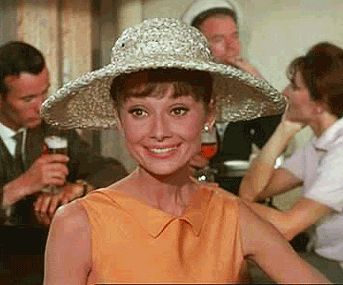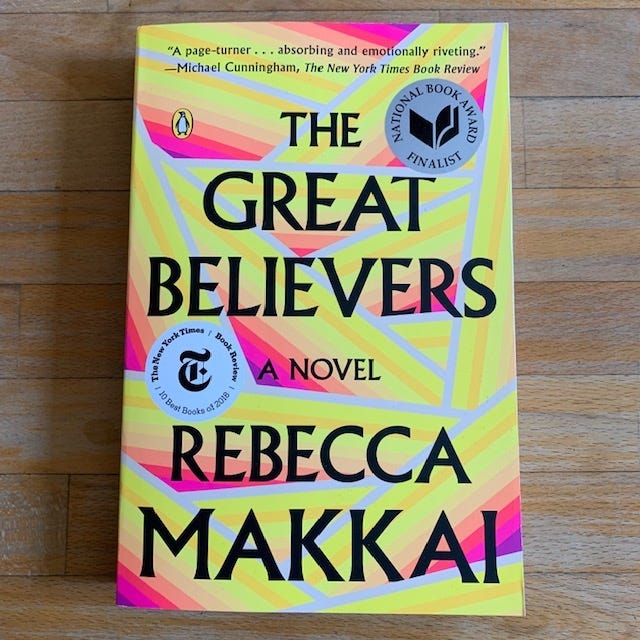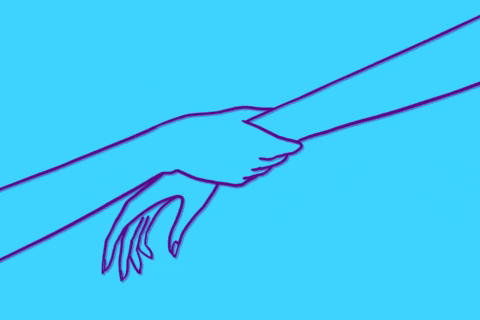
This beautiful and heartbreaking book completely bummed me out. Seriously, I headed to the bar around the corner for a drink after I finished this Sunday’s selection, ‘The Great Believers’ by Rebecca Makkai:

This novel, which was a National Book Award finalist, opens in 1985 during the AIDS crisis in Chicago. We meet the two protagonists at a memorial service for Nico, a gay man killed by the disease. Yale is one of Nico’s close friends. Fiona is Nico’s younger sister and, although she is a reappearing character in Yale’s timeline, her story is primarily set in Paris in 2015. As their point-of-view chapters alternate, we see Yale work to bring a big art donation to a gallery at Northwestern University, where he works. The paintings are being donated by Nora, Fiona’s elderly aunt, who studied to be an artist in Paris before and after World War I, and who rubbed elbows with Modigliani and other artists of that era, and collected some of their works. The donation is complicated by Nora’s family, who instead want to cash in on the collection’s value. In Fiona’s chapters, we see her searching for her estranged daughter, Claire, who has fled from a cult and moved to Paris with her toddler-aged child. As both timelines progress, they recreate Chicago in the late 80s and early 90s as AIDS ravages that city’s gay community in Boystown, and Yale and Fiona lose friends, lovers and acquaintances one by one, like:

Makkai did a good job recalling the tremendous fear and ignorance surrounding AIDS and homosexuality during the Reagan era. We see the tell-tale purple lesions, the indifference from the federal government and the health-care industry to fighting the disease, and the consequences of unprotected sex. And we also see the discrimination gay men faced from society and their own families. Nico’s family, for example, excludes his gay friends and his partner, Terrence, from his funeral in an attempt to deny they even exist. Yale gives Fiona power of attorney over his medical care after his parents have little to do with him. As I was finishing this book, the ‘American Dirt’ controversy about cultural appropriation and racial stereotyping in that new novel was playing out online. (If you’re not familiar with the issue, the Los Angeles Times has a good writeup here.) I wondered if there was a similar issue with ‘The Great Believers.’ Makkai addresses the issue in her acknowledgements, where she writes: ‘This project was undertaken with a great deal of ongoing thought and conversation about the line between allyship and appropriation—a line that might feel different to different readers. It is my great hope that this book will lead the curious to read direct, personal accounts of the AIDS crisis—and that any places where I’ve gotten the details wrong might inspire people to tell their own stories.’ She discusses the issue at greater length in Lit Hub. I couldn’t find any commentary from gay men about it, but Chicago’s LGBTQ publication Windy City Times gave it a positive review. Shoot me an email if you disagree, but it seems to me that this book is not coming from a place of appropriation, but rather one of empathy and:

I don’t want to give away too much about the book, but I want to point out a few minor details that have personal significance. One is a passing mention of the Mars Cheese Castle in Kenosha, Wisconsin. It’s run by a man who has the same name I do. I want to meet him one day and try his cheese. Another is a cameo by DePaul University, which late in the book provides Yale needed employment and health insurance. Donna went to DePaul, and its alumni network has made me feel more welcome than my own alma mater, Boston College. Lastly, there is a fleeting reference to Caravaggio’s painting of St. Jerome. It’s a painting I think about a lot, and I have a framed postcard of it on my nightstand. In it, St. Jerome is hard at work; I believe he’s translating the Bible into Latin. On his desk is a skull, a memento mori. Caravaggio is reminding us that even though we work hard and feed our passions, death awaits. Makkai’s book offers a similar message. The great believers, I think, are all of us who believe that time is on our side, and that in life it’s possible to attain things that are real and permanent. In the book, Yale believes he can find love, companionship and stability even as his world falls apart. Fiona believes she can fix her relationship with Claire by being present in her life. We all need this kind of optimism in order to get out of bed in the morning, because the reality is far too sad to think about. Our lives—and those of our friends and loved ones—are far from permanent. As I write this, the world is mourning the loss of Kobe Bryant, his daughter Gianna, and several others who were killed in a helicopter crash. It’s a painful reminder that we are all teetering on the brink, like:

Near the end of the book, Fiona and Claire attend a photography exhibit for one of Fiona’s old friends from Chicago named Richard. He survived the AIDS crisis and documented it with photos and home movies. The images on display are of young men full of life, many of whom are now dead. Richard says to Claire the line that sent me to the bar: ‘You’re not always advancing. I know it feels that way now, but it’s fragile. You might look back in fifty years and say, That was the last good time.’ After reading that, I was like:

It may not seem like it from this review, but ‘The Great Believers’ does contain moments of joy and humor. For example, I loved that Nico’s scarf kept popping up here and there to provide comfort. I also loved Yale’s bittersweet triumph in fulfilling Nora’s request to have her artwork displayed in a certain way. Makkai’s book is beautifully written, and I flew through it. It tells an important story, and I recommend it to you all. Though it can be a bummer, it should also inspire us to continue to live, to strive and to believe.
How it begins:
Twenty miles from here, twenty miles north, the funeral mass was starting. Yale checked his watch as they walked up Belden. He said to Charlie, “How empty do you think that church is?”
Charlie said, “Let’s not care.”
The closer they got to Richard’s house, the more friends they spotted heading the same way. Some were dressed nicely, as if this were the funeral itself; others wore jeans, leather jackets.
It must only be relatives up at the church, the parents’ friends, the priest. If there were sandwiches laid out in some reception room, most were going to waste.
Yale found the bulletin from last night’s vigil in his pocket and folded it into something resembling the cootie catchers his childhood friends used to make on buses—the ones that told your fortune (“Famous!” or “Murdered!”) when you opened a flap. This one had no flaps, but each quadrant bore words, some upside down, all truncated by the folds: “Father George H. Whitb”; “beloved son, brother, rest in”; “All things bright and”; “in lieu of flowers, donatio.” All of which, Yale supposed, did tell Nico’s fortune. Nico had been bright and beautiful. Flowers would do no good.
My rating:

‘The Great Believers’ by Rebecca Makkai was published by Viking in 2018 and Penguin Books in 2019. 418 pages. $16 at Books Are Magic.
More things worth your time:
Read this: Some of you may have seen the controversy playing out across social media over Jeanine Cummins’s new novel, ‘American Dirt.’ At issue is whether Cummins stereotypes and appropriates the struggle of Mexican immigrants amid the current border crisis. (Also at play is whether Cummins and her publisher, Flatiron, are just plain tacky and clueless as evidenced by barbed-wire-decorated floral centerpieces at her book party and her matching fingernails.) Myriam Gurba’s piece from December, ‘Pendeja, You Ain’t Steinbeck: My Bronca with Fake-Ass Social Justice Literature,’ on Tropics of Meta is absolutely searing. The piece includes a review Gurba wrote for another publication that was killed because an editor thought it lacked ‘something redeeming’ about ‘American Dirt.’ It also has this great line: ‘Dirt is a Frankenstein of a book, a clumsy and distorted spectacle and while some white critics have compared Cummins to Steinbeck, I think a more apt comparison is to Vanilla Ice.’
Look at this: Mast Books recently featured this image on its Instagram feed of an ‘extremely rare’ Keith Haring flyer, in English and Spanish, created in 1989 to raise awareness of an AIDS hotline in New York City. The price was not included in the post.
Do this: Author Paul Yoon launches his new novel ‘Run Me to Earth’ on Thursday, Jan. 30, at 7:30 p.m., with a conversation with Hernán Díaz at Greenlight Bookstore. Yoon’s book is about ‘three children orphaned in 1960s Laos, doing what is necessary to survive perilous times.’ Many of you will remember that I reviewed Díaz’s wonderful book ‘In the Distance’ late last year.

In two weeks you’ll get a review of ‘Go Ahead in the Rain’ by Hanif Abdurraqib. Also in the queue are ‘Barracoon’ by Zora Neale Hurston, ‘Killers of the Flower Moon’ by David Grann and ‘The Simple Past’ by Driss Chraïbi, among others.
In case you missed it: Books on GIF #123 featured ‘Evicted: Poverty and Profit in the American City’ by Matthew Desmond.
Shoot me an email if there’s a bestseller, a classic or a forgotten gem you want reviewed.
Please click the heart button above if you enjoyed this newsletter. You can also share it with a friend:
Follow me on Twitter and Instagram.
Thanks for reading, and thanks especially to Donna for editing this newsletter!
Until next time,

MPV



